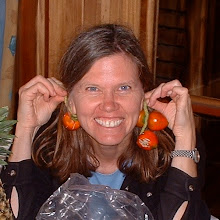Recently I stitched a few balls that are completely or almost completely covered with embroidery. This style of temari is called kousa. This kind of design demands a much great degree of accuracy in the roundness of the ball, the marking, and the stitching. And because of all the stitches needed to cover the ball they take relatively longer to do.
Once again, thank goodness for the internet where I found these lovely patterns. The first all-over design I did—shown on the left— is pattern GT31 by Ginny T. on TemariKai.com. She describes it as being fairly forgiving for this type of design. That was definitely a good thing for my first attempt at kousa.
The ball on the right is also from TemariKai.com. It's pattern CP02 by Colleen P. The same ball can be seen from a different angle in the photo below. It's quite magical how the pattern forms as you stitch and do under and overs.
The ball on the left is a much simpler design. It's pattern SC02 by Susan C. on TemariKai.com. It's on a simple 10 division with a spindle stitched in each section. Then an obi of the same color as the base (black in this case) is woven through the spindles. Simple and very effective. On all of these balls I chose my own colors. This one used some of the wonderful greens I bought in Guatemala last year in perle 8, which is finer than the size 5 I usually use.
Once again, thank goodness for the internet where I found these lovely patterns. The first all-over design I did—shown on the left— is pattern GT31 by Ginny T. on TemariKai.com. She describes it as being fairly forgiving for this type of design. That was definitely a good thing for my first attempt at kousa.
The ball on the right is also from TemariKai.com. It's pattern CP02 by Colleen P. The same ball can be seen from a different angle in the photo below. It's quite magical how the pattern forms as you stitch and do under and overs.







No comments:
Post a Comment